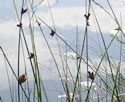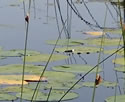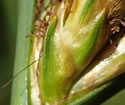Schoenoplectus torreyi (Torrey's Bulrush)
| Also known as: | |
|---|---|
| Genus: | Schoenoplectus |
| Family: | Cyperaceae (Sedge) |
| Life cycle: | perennial |
| Origin: | native |
| Habitat: | part shade, sun; wet sandy or peaty soil, often in shallow water; lakes, ponds, marshes |
| Fruiting season: | July - September |
| Plant height: | 20 to 50 inches |
| Wetland Indicator Status: | GP: OBL MW: OBL NCNE: OBL |
| MN county distribution (click map to enlarge): |  |
| National distribution (click map to enlarge): |  |
Pick an image for a larger view. See the glossary for icon descriptions.
Detailed Information
Spikes: 

![[photo of spikelet cluster]](/udata/r9ndp23q/grass/schoenoplectus-torreyi_0823_153633-t.jpg) One to 4 stalkless spikelets at the top of the stem, subtended by an erect bract 1 to 8 inches long that appears to be a continuation of the stem, so the cluster seems to be growing out from the side of the stem. Spikelets are 7 to 18 mm (~¼ to ¾ inch) long, lance-elliptic, blunt to rounded at the tip, orange-brown to straw colored, with florets spirally arranged. Florets are perfect (both male and female parts) each with a 3-parted style and subtended by a single scale.
One to 4 stalkless spikelets at the top of the stem, subtended by an erect bract 1 to 8 inches long that appears to be a continuation of the stem, so the cluster seems to be growing out from the side of the stem. Spikelets are 7 to 18 mm (~¼ to ¾ inch) long, lance-elliptic, blunt to rounded at the tip, orange-brown to straw colored, with florets spirally arranged. Florets are perfect (both male and female parts) each with a 3-parted style and subtended by a single scale.
Leaves and stems: 

![[photo of leaves]](/udata/r9ndp23q/grass/schoenoplectus-torreyi_0824_102448-t.jpg) Four to 7 leaves are alternately arranged on the lower half of the stem, V-shaped in cross-section, the lowest reduced to bladeless sheaths, the upper 3 to 6 with a stiff, erect blade up to 2 mm wide, usually longer than its sheath and may be as long as or longer than the stem. Sheath fronts are finely fibrous. Stems are erect, firm, 3-sided (usually sharply so), the sides flat to concave on the upper stem. Plants form colonies from soft rhizomes.
Four to 7 leaves are alternately arranged on the lower half of the stem, V-shaped in cross-section, the lowest reduced to bladeless sheaths, the upper 3 to 6 with a stiff, erect blade up to 2 mm wide, usually longer than its sheath and may be as long as or longer than the stem. Sheath fronts are finely fibrous. Stems are erect, firm, 3-sided (usually sharply so), the sides flat to concave on the upper stem. Plants form colonies from soft rhizomes.
Fruit: 
![[photo of scales and achenes]](/udata/r9ndp23q/grass/schoenoplectus-torreyi-082517-3-t.jpg) Fruit develops in summer, the mature achenes (seeds) dropping off individually.
Scales
are 4 to 5 mm long, about 2.5 mm wide, orange-brown to straw-colored, the green midrib turning brown, lance-elliptic, tapering to rounded at the tip (rarely minutely notched) with the midrib extending slightly to a sharp point.
Achenes
are 3.5 to 4.5 mm long, 1.7 to 2 mm wide, compressed 3-sided, urn-shaped in outline with a beak up to 1 mm long, smooth and maturing to brown. Surrounding the base are 6 barbed, light brown bristles that are about as long as or slightly longer than the achene.
Fruit develops in summer, the mature achenes (seeds) dropping off individually.
Scales
are 4 to 5 mm long, about 2.5 mm wide, orange-brown to straw-colored, the green midrib turning brown, lance-elliptic, tapering to rounded at the tip (rarely minutely notched) with the midrib extending slightly to a sharp point.
Achenes
are 3.5 to 4.5 mm long, 1.7 to 2 mm wide, compressed 3-sided, urn-shaped in outline with a beak up to 1 mm long, smooth and maturing to brown. Surrounding the base are 6 barbed, light brown bristles that are about as long as or slightly longer than the achene.
Notes:
Schoenoplectus torreyi, formerly Scirpus torreyi, is an occasional bulrush found in lakes, ponds and marshes mostly in the northeast quadrant of the state, often in standing water and preferring sandy or peaty soils; it reaches the western edge of its range in Minnesota. It resembles 2 other Schoenoplectus species in Minnesota, Schoenoplectus pungens and Schoenoplectus subterminalis. All 3 share the common traits of a 3-sided stem and 1 to a few spikelets with an erect bract that appears to be a continuation of the stem, so it appears the spikelets grow out from the side of the stem. S. torreyi is the least common of the 3 in Minnesota, distinguished by a stem that is (usually) sharply 3-sided, stiff leaves up to 2 mm wide and may be as long as the stem, 1 to 4 spikelets, floral scales that are not notched or awned at the tip, 6 bristles that are as long as or shorter than the achene and may be unequal in length.
By comparison, S. pungens floral scales are deeply notched at the tip and have an awn longer than the notch lobes, the stem is more stout, leaves are up to 9 mm wide, and bristles are mostly shorter than the achene and may be dissimilar in length. S. subterminalis is the most diminutive of the 3 species, with a very slender stem (1mm wide or less), single spikelet, and numerous long, limp, thread-like leaves that tend to stay submerged. In Minnesota, S. torreyi plants are generally intermediate in size between the other two species.
Compare these with other Bulrush species, which may differ by their round stems, leaf-like bracts, essentially leafless or distinctly leafier stems, globular or branching clusters of numerous small spikelets, or other traits not as above.
Native Plant Nurseries, Restoration and Landscaping Services ↓
More photos
 Schoenoplectus torreyi plants
Schoenoplectus torreyi plants Schoenoplectus torreyi plants
Schoenoplectus torreyi plants Schoenoplectus torreyi plants
Schoenoplectus torreyi plants Schoenoplectus torreyi plants
Schoenoplectus torreyi plants close-up of spikelets
close-up of spikelets comparison of Schoenoplectus pungens and S. torreyi stems in cross-section
comparison of Schoenoplectus pungens and S. torreyi stems in cross-section
Photos by K. Chayka and Peter M. Dziuk taken in Cass and Crow Wing counties.
Comments
Have you seen this plant in Minnesota, or have any other comments about it?






